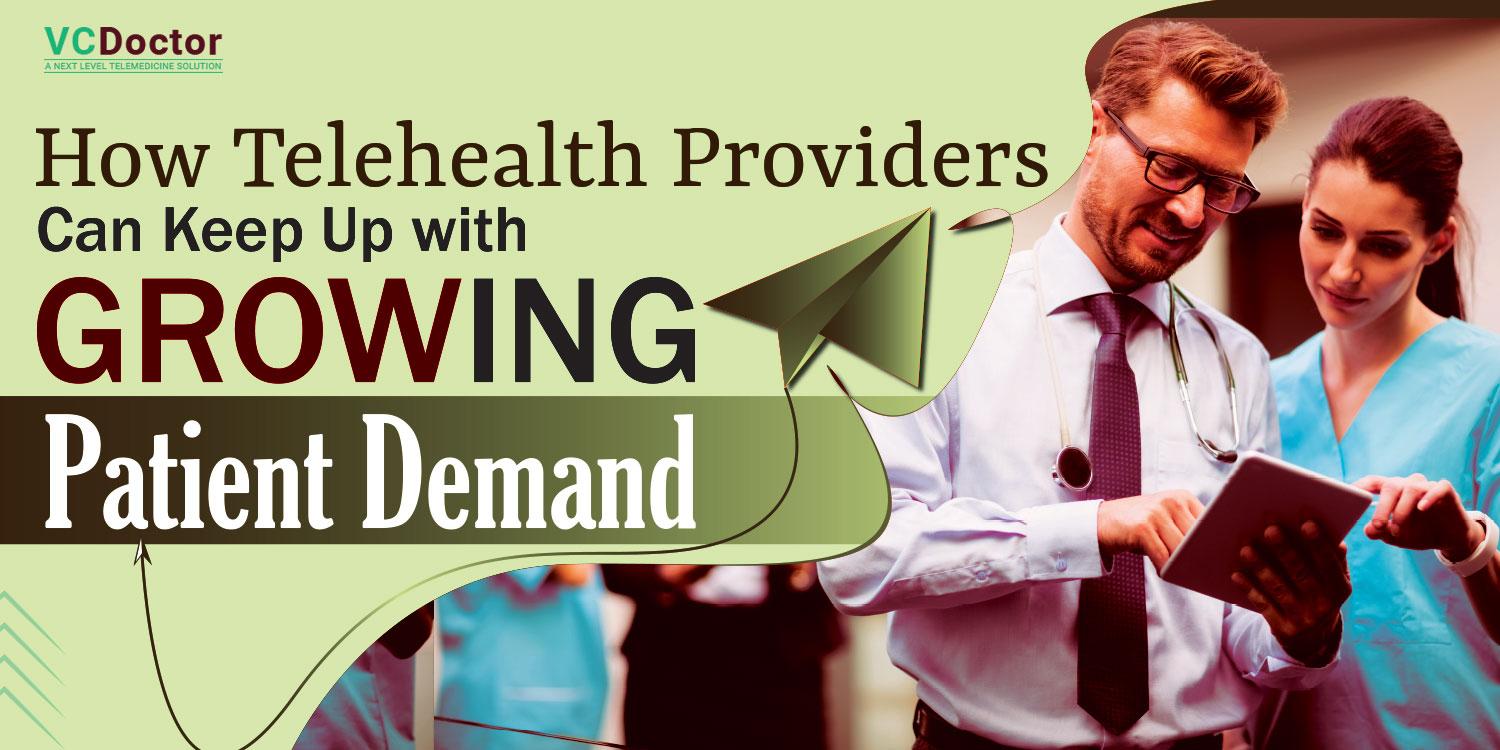How Can Telehealth Providers Keep Up with Growing Patient Demand?
Telehealth Providers Can Keep Up with Growing Patient Demand because the need for healthcare services is increasing nationwide. Every ten years, the population of the United States increases by about 25 million people. As the population rises, the demand for healthcare services also rises. Additionally, as the population ages, the demand for healthcare services also increases.
Telehealth platforms can help healthcare facilities make the most of their existing resources. Telehealth offers features like video consultation and remote patient monitoring. Providers can better assess patients’ needs and provide more effective care.
This blog will discuss how Telehealth devices can meet growing patient demand. First, see what Telehealth is. So, read out the article carefully to gain insight into the topic.
Table of Contents
- What is Telehealth?
- What is Telehealth Providers Technology?
- mHealth—Using Smartphones and Tablets for Telehealth
- Video Conferencing, Video Scopes, and High-Resolution Cameras in Telehealth Providers
- Remote Patient Monitoring (RPM)
- Store and Forward
- The Growing Demand for Healthcare
- How Telehealth Can Ease the Burden Placed on Providers
- Using Telehealth Providers More Effectively
- Key Takeaways
What is Telehealth?
Telehealth is the use of technology to provide healthcare services from a distance. Telehealth services are of different types. These include:
- Remote patient health monitoring
- Online consultations with a doctor
- Home-based rehabilitation programs
Telehealth services offer several advantages for patients, healthcare providers, and organizations.
- Telehealth offers quick access to care, improved convenience, and increased privacy and confidentiality.
- Telehealth services help providers improve the quality of care and patient outcomes.
- Telehealth services help healthcare organizations reduce costs.
What is Telehealth Providers Technology?
Telehealth providers use a variety of technologies to provide services to patients. This technology can include:
- Video conferencing to connect with patients,
- Electronic health records to track patient health information,
- And telemedicine to provide consultations.
mHealth—Using Smartphones and Tablets for Telehealth
mHealth uses mobile devices and telecommunications technologies to improve health and health care. mHealth is a broad term that can refer to various health-related activities.
Some typical mHealth applications include:
• RPM for measuring and tracking heart rate, blood pressure, and blood sugar levels
• Remote health monitoring and care, such as for patients with chronic conditions
• Health education and information, such as dietary advice or medication reminders
• Health-related networking, such as connecting with other patients or healthcare professionals
mHealth has the potential to improve health and health care in many ways. It can help people to make more informed health decisions. It can also help them to connect with healthcare professionals when needed. mHealth can also help to improve the quality and efficiency of healthcare delivery.
Read Also: How Telemedicine Helps The Doctors To Reduce The Cost
Video Conferencing, Video Scopes, and High-Resolution Cameras in Telehealth Providers
Providers are using video conferencing, video scopes, and high-resolution cameras for patients care. These technologies allow providers to connect with patients from a distance. It can benefit patients who cannot travel to a provider’s office.
Video conferencing allows providers to communicate with patients and other healthcare professionals remotely. It can be helpful for patients living in underserved areas or unable to travel. Video conferencing can also provide educational sessions to patients.
Video scopes are small, handheld devices that allow providers to see inside a patient’s body. It can help diagnose conditions such as pneumonia or cancer. Video scopes can also guide procedures such as biopsies.
High-resolution cameras can capture images of a patient’s body in great detail. It can help diagnose conditions and for planning treatments. These cameras can also capture images of a patient’s face. It can help assess their mood or detect changes in their condition.
Remote Patient Monitoring (RPM)
Remote patient monitoring can help healthcare providers to check patients remotely. It will help free up time for healthcare providers to see more patients.
Additionally, RPM can improve patient care with real-time patient data. It can collect, store, and share data on patient vital in real-time. It can help providers with more accurate diagnoses and make better decisions.
Store and Forward
Store and Forward Telehealth transmits health information from one location to another. It can offer care to patients who cannot travel to a healthcare facility or care for remote patients. It also allows providers to share patient information. It facilitates better collaboration and knowledge transfer between healthcare experts, teams, and organizations. The technology is 100% secure and HIPAA compliant.
Read Also: Difference Between Healthcare Information Security And HIPAA Compliance
The Growing Demand for Healthcare
The U.S. industry has the fastest-growing healthcare employment. By 2030, there will be twice as many citizens over 65 who will need 24-hour medical attention.
Senior individuals need twice as many medical services as younger patients. Additionally, they are at higher risk of chronic illnesses. These include diabetes, hypertension, arthritis, and asthma.
Elderly or chronic patients may find it challenging to visit a doctor in person. In some cases, healthcare professionals have to travel to these patients. They also sometimes make arrangements for patients to get to the facility.
How Telehealth Can Ease the Burden Placed on Providers
Health systems of all sizes might need more employees to meet growing demand. Telehealth can assist healthcare professionals in making better use of their time. Telehealth services can reduce the typical length of stay. So this reduces the time providers must spend caring for patients face-to-face.
Providers can also save time by communicating with patients using virtual health care. They don’t have to worry about their patients skipping or arriving late to appointments. Patients can consult doctors via live video and voice from their homes.
Additionally, infectious diseases can disrupt care for other patients. With the telehealth platform, care remains uninterrupted. Providers can continue to monitor their patients as they recover safely at home. By seeing patients remotely or using less on-site staff, providers can also extend their hours of operation.
There is also a growing body of evidence supporting telehealth use for preventive care. Telehealth users are more likely to receive preventive care services.
Using Telehealth Providers More Effectively
Providers must have access to patient data during virtual consultations. The platform must support secure patient medical records storage and retrieval. It helps them review the patient’s history and make informed decisions in real time. As a result, there will be fewer needs for follow-ups and unplanned visits.
Providers can also use telehealth to share their knowledge and experience. There aren’t many specialized providers available in remote places. General practitioners and urgent care facilities can communicate with specialists online. It will ensure the timely delivery of care to patients who need it the most.
There are a few ways that providers can use telehealth services more effectively. One way is to ensure that patients are aware of the telehealth services that are available to them. Providers can also provide telehealth services during convenient hours.
On top of it all, providers can use the best of both worlds to manage ever-growing demand. They can:
1. Offer in-person visits for patients who need more intensive care or support.
2. Offer telehealth visits for patients who only need occasional check-ins or support.
3. Offering in-person visits for patients who live close to the provider’s office
4. Offering telehealth visits for patients who live further away.
Looking for Best HIPAA Complaint Telemedicine Platform
Key Takeaways
Worldwide, providers are seeing an increase in patient demand. Healthcare IT innovations like telehealth help providers seamlessly offer care.
With Telehealth to their aid, providers can connect with patients in real-time. Telehealth offers a convenient and efficient way for patients to connect with providers. It can reduce the need for in-person appointments. It also reduces wait times and improves access to care.
Telehealth can also help to improve care coordination. Providers can communicate and share information securely. This can help to ensure that patients receive the best possible care.




